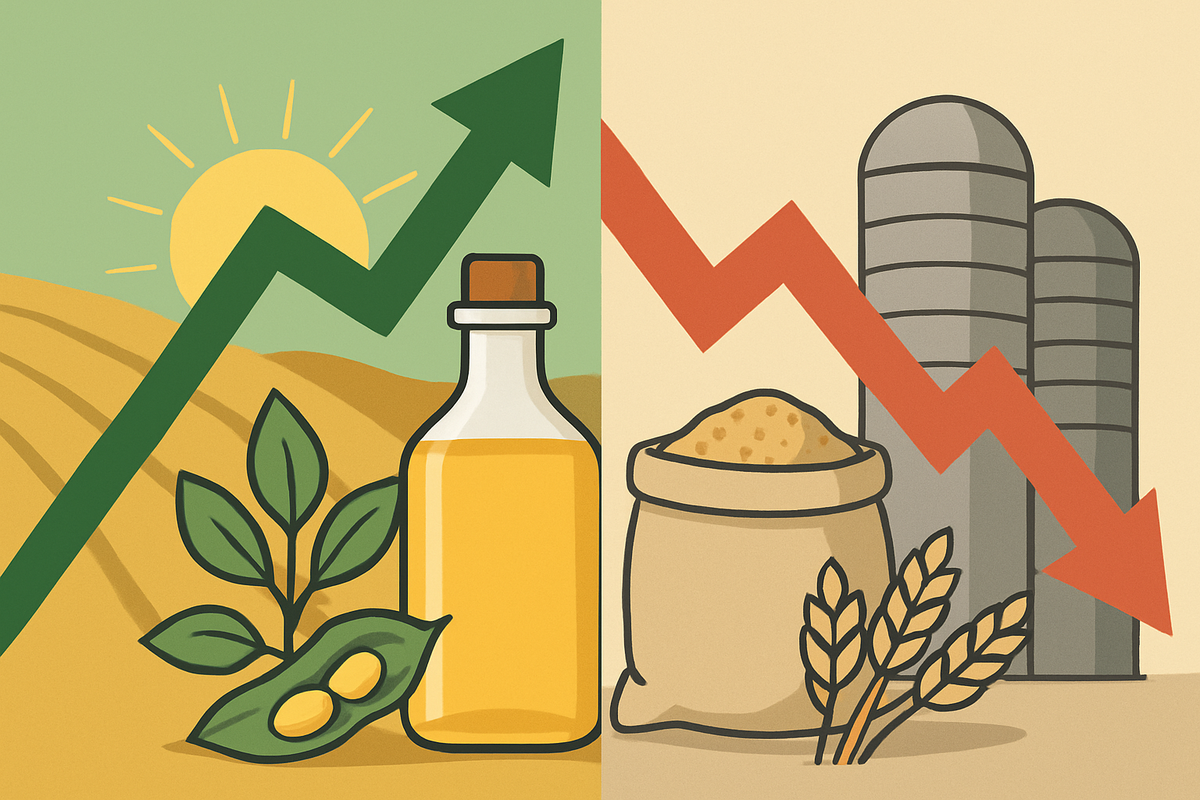Financial News
Bank of America Forecasts Divergent Paths for Key Agricultural Commodities in 2026

Bank of America (BofA) has unveiled a nuanced outlook for major agricultural commodities in 2026, presenting a stark contrast between an optimistic forecast for soybean oil and bearish predictions for both wheat and soymeal. This mixed sentiment reflects a complex interplay of global supply dynamics, evolving demand patterns, and critical regulatory influences, signaling a period of significant shifts for producers, traders, and consumers within the agricultural sector. The bank's projections, released ahead of the 2026 trading year, suggest that while certain segments are poised for growth, others face headwinds that could depress prices and impact profitability.
The immediate implications of BofA's analysis point to a strategic re-evaluation for market participants. For those involved in the burgeoning biofuel industry, particularly with soybean oil as a feedstock, the outlook appears favorable. Conversely, stakeholders in the wheat and soymeal markets may need to brace for lower prices and potentially tighter margins, necessitating adjustments in production, storage, and sales strategies to navigate an anticipated surplus environment. The diverging paths underscore the increasing segmentation of commodity markets, where global factors can dramatically impact individual agricultural products differently.
Detailed Analysis of Bank of America's Commodity Outlook
Bank of America's detailed assessment for 2026 paints a clear picture of anticipated market conditions for these crucial agricultural staples. The bank's analysts have meticulously dissected supply and demand fundamentals, alongside regulatory impacts, to arrive at their varied conclusions.
For soybean oil, Bank of America projects a "strong bullish trajectory" into 2026. This optimism is primarily anchored in robust demand prospects, largely driven by its increasing utilization in biofuel production, coupled with anticipated constrained supply. The U.S. Department of Agriculture (USDA) supports this demand narrative, projecting 15.5 billion pounds of soybean oil for biofuel production in the 2025-2026 period, maintaining a stable price forecast of 53 cents per pound. The bank notes that the full upside potential for soybean oil prices remains contingent on forthcoming regulatory frameworks, particularly those pertaining to renewable fuels, which could further solidify its demand base.
In stark contrast, wheat faces a "bearish outlook" from Bank of America for 2026. This pessimistic view is largely a consequence of improved global supply conditions. Analysts point to stronger-than-expected harvests and aggressive export sales, particularly from the Black Sea region, including Russia, which are contributing to a significant increase in global grain inventories. Furthermore, planned expansions in planted acreage across key growing regions are expected to further bolster supply, potentially leading to a projected decline in global wheat prices. Some commodity analysts, echoing BofA's sentiment, forecast a 10-15% drop by 2026, assuming stable weather patterns and uninterrupted trade flows.
Similarly, soymeal is also subject to a "bearish stance" by Bank of America, with a 2026 price target set at $285 per ton, a notable decrease from the current forward price of $308 per ton. The core reasoning behind this downward revision is the expectation of persistent "surplus conditions." This anticipated surplus is driven by increasing U.S. soybean crush volumes, projected to rise by 6% year-over-year in 2024/25 and approximately 5% year-over-year in 2025/26. These higher crush volumes are directly influenced by the Environmental Protection Agency's (EPA) proposed record Renewable Volume Obligations (RVOs) for 2026-2027, which incentivize soybean processing. Despite an expected increase in domestic feed use for soymeal, projected at +4.5% year-over-year in 2025/26 due to growing chicken numbers and record livestock weights, BofA analysts express concern about sufficient demand to prevent an inventory buildup. The export outlook for soymeal also presents challenges, facing stiff competition from South American origins and expectations of weaker feed demand within the European Union, a significant destination market.
Market Movers: Winners and Losers in the Commodity Shift
Bank of America's divergent forecasts for soybean oil, wheat, and soymeal in 2026 are set to create distinct winners and losers across the agricultural supply chain, impacting major public companies involved in processing, biofuel production, animal agriculture, and packaged foods. The interplay of higher soybean oil prices and lower wheat and soymeal costs will necessitate strategic adjustments and could significantly alter profitability metrics.
Companies heavily invested in soybean processing and biofuel production are poised for a mixed, but often net positive, outcome. Agricultural giants like Archer-Daniels-Midland (NYSE: ADM) and Bunge Global SA (NYSE: BG) are significant soybean crushers. While a bearish outlook for soymeal, a co-product of soybean crushing, could pressure one revenue stream, the anticipated "strong bullish trajectory" for soybean oil is expected to significantly boost the value of their primary output. This dynamic is likely to enhance overall crush margins, positioning them as net beneficiaries. However, for biofuel producers like Darling Ingredients (NYSE: DAR), whose Diamond Green Diesel joint venture can utilize soybean oil as a feedstock, higher soybean oil prices could translate into increased input costs, potentially impacting their fuel ingredients segment negatively.
The animal agriculture sector stands to be a clear winner from the bearish forecasts for wheat and soymeal. Major meat and poultry producers, including Pilgrim's Pride (NASDAQ: PPC) and Tyson Foods (NYSE: TSN), are substantial consumers of animal feed. Wheat and soymeal constitute significant components of these feed formulations. Therefore, lower prices for these commodities would directly translate into reduced operating expenses, substantially improving their margins and profitability. This cost relief comes at a crucial time for an industry often sensitive to feed price volatility.
Furthermore, packaged food companies that rely on wheat as a primary ingredient are also likely to benefit. Companies such as General Mills (NYSE: GIS), known for its cereals and baked goods, would see a substantial reduction in raw material costs due to the bearish wheat outlook. While some packaged food companies, like Kraft Heinz (NASDAQ: KHC) and Conagra Brands (NYSE: CAG), also use vegetable oils, the positive impact from cheaper wheat is anticipated to largely outweigh the negative impact of higher soybean oil prices, leading to a mixed but often favorable net effect on their ingredient expenditures.
Broader Implications: Navigating a Fragmented Agricultural Landscape
Bank of America's 2026 commodity forecasts for soybean oil, wheat, and soymeal extend far beyond mere price predictions, revealing profound implications for global industry trends, food security, and the geopolitical undercurrents shaping agricultural trade. These diverging outlooks underscore a complex and increasingly fragmented global agricultural landscape.
The optimistic forecast for soybean oil is intrinsically linked to the accelerating global push for renewable energy. Government mandates and incentives, such as the EPA's Renewable Volume Obligations (RVOs), are significantly bolstering demand for soybean oil as a crucial feedstock for biofuel production. This trend highlights the growing nexus between energy policy and agricultural markets, where the drive for decarbonization directly impacts the value and utilization of crops. The continued expansion of the biofuel sector is expected to keep demand for vegetable oils robust, potentially leading to ongoing competition between food and fuel uses for these essential agricultural products.
Conversely, the bearish outlook for wheat and soymeal must be considered within the context of global food security. While projections of softer wheat prices in the latter half of 2026, driven by strong South American supply, might suggest an easing of food costs, this does not automatically translate to improved food security for all. The World Food Programme's (WFP) dire 2026 Global Outlook, estimating 318 million people facing acute hunger, emphasizes that access, distribution, and the devastating impacts of conflict and climate on local production remain critical challenges, irrespective of global commodity price trends. The WFP's confirmation of simultaneous famines in Gaza and parts of Sudan underscores the complex interplay of geopolitical instability and food access.
Indeed, geopolitical impacts on grain trade are increasingly superseding traditional supply and demand dynamics as the dominant force in shaping global agricultural markets. Rabobank's 2026 outlook suggests a bifurcation into distinct spheres of influence, primarily led by the U.S. and China, where agricultural exports are leveraged as tools of political pressure. This fragmentation, driven by trade conflicts and rising government subsidies in major agricultural nations, distort market signals and is expected to keep planted areas high, contributing to subdued grain and oilseed prices. U.S. tariffs have already reshaped global grain trade, leading to retaliatory tariffs and a reduced reliance on U.S. soybeans by China, consequently benefiting competitors like Brazil and Argentina who are expanding production and gaining market share.
Beyond the EPA's RVOs, broader regulatory and policy implications are also at play. The rise of trade protectionism, tariffs, and government subsidies—including direct payments and minimum price guarantees—is anticipated to intensify. The EPA's proposed changes to the Renewable Fuel Standard (RFS) program, such as reducing Renewable Identification Numbers (RINs) for imported renewable fuel, signal a clear policy direction aimed at bolstering domestic biofuel production. However, debates around reallocating small refinery exemptions (SREs) from previous years raise concerns about potentially inflating compliance costs for refiners and diverting soybean oil from food to fuel production, which could, in turn, impact consumer food prices. Historically, commodity markets have always been sensitive to such policy shifts, with past periods of trade protectionism and resource nationalism offering precedents for the current fragmented environment.
The Road Ahead: Navigating Future Market Dynamics
Looking ahead to 2026, Bank of America's forecasts suggest a period of distinct challenges and opportunities across the soybean oil, wheat, and soymeal markets. The interplay of burgeoning biofuel demand, global supply dynamics, and persistent geopolitical influences will dictate the short-term fluctuations and long-term trajectories for these critical agricultural commodities.
For soybean oil, the "strong bullish trajectory" is expected to continue, driven primarily by the relentless expansion of the renewable diesel and Sustainable Aviation Fuel (SAF) sectors. In the short term, market participants will be keenly watching for clarity on pending regulatory frameworks, as favorable policies could further solidify demand and underpin higher prices. Long-term, the strategic pivot for producers and processors will involve exploring diversified feedstock sources for biofuels beyond traditional corn and soy, while also managing the "food vs. fuel" debate to ensure sustainable growth. Opportunities lie in technological advancements in biofuel production and the expansion into new renewable fuel markets, but challenges include potential price volatility if regulatory support wavers or if the balance between food and fuel demand becomes strained.
The wheat market, facing a bearish outlook, necessitates a proactive and adaptive approach from producers and traders. In the short term, the market will likely continue to absorb abundant supply from key exporting regions, especially the Black Sea, leading to subdued prices. Long-term, wheat farmers and traders must prepare for a highly competitive global trading environment. Strategic adaptations include meticulous monitoring of geopolitical stability in major producing regions, proactive management of input costs, and exploring revenue diversification strategies for farmers. While overall prices may be depressed, localized supply deficits due to extreme weather events could present temporary trading opportunities. However, the dominant challenge remains navigating a market characterized by ample global supply.
Similarly, the soymeal market is grappling with a persistent surplus, reinforcing Bank of America's bearish view. Short-term, soymeal prices are expected to remain under pressure, having already reached multi-year lows due to increasing crush volumes. Long-term, the key challenge for soymeal producers and traders will be to stimulate sufficient demand to absorb the projected surplus. This requires optimizing crush volumes and aggressively seeking new demand outlets beyond traditional domestic animal feed use and existing export markets. Competition from South American origins and anticipated weaker feed demand in the European Union will make the export landscape particularly challenging. Opportunities might emerge in regions with expanding livestock industries and less local production, but success hinges on overcoming significant logistical and competitive hurdles.
The overarching theme across these commodities is the intricate interplay of biofuel demand, global supply, and geopolitical factors. The robust demand for soybean oil in the biofuel sector, while positive for oil prices, indirectly contributes to the soymeal surplus as more soybeans are crushed. Global supply dynamics, particularly from South America, will continue to exert significant influence, potentially softening prices for soybeans and corn in the latter half of 2026. Geopolitical tensions, trade policies, and the purchasing behavior of major importers like China will remain critical drivers of market volatility. While a potentially more market-friendly policy backdrop under a new U.S. administration could reduce trade tensions, the stability of key export corridors, such as the Black Sea for wheat, remains a significant geopolitical risk factor that could rapidly alter market conditions.
Concluding Thoughts: A Bifurcated Agricultural Future
Bank of America's 2026 outlook for soybean oil, wheat, and soymeal paints a compelling picture of an agricultural market poised for significant divergence. The analysis underscores a future where demand drivers, supply dynamics, and geopolitical forces create distinct trajectories for individual commodities, demanding strategic agility from all market participants.
Key takeaways from BofA's forecast highlight the robust, policy-driven demand for soybean oil, largely fueled by its critical role in the burgeoning biofuel sector. This provides a structural underpin to prices, setting it apart from the more traditional agricultural commodities. Conversely, wheat and soymeal face a challenging landscape dominated by ample global supply and intense competition, leading to bearish price expectations. The increasing influence of geopolitical factors, particularly in grain trade and energy policy, is a defining characteristic of this new environment.
Moving forward, the agricultural market is set for a period of strategic adaptation. The biofuel mandate for soybean oil effectively creates a unique demand floor, potentially decoupling its price movements from broader agricultural trends. For wheat and soymeal, however, market participants must contend with persistent oversupply, necessitating a focus on cost efficiency, market diversification, and a keen awareness of global supply-and-demand fundamentals. Geopolitical decisions, particularly concerning trade between major economic powers, will continue to cast a long shadow, influencing everything from planting decisions to export flows.
The significance and lasting impact of these diverging forecasts are profound. The optimistic view for soybean oil solidifies the intertwining of agricultural production with renewable energy policies, promising a more resilient, policy-supported demand base for oilseeds. This could reshape planting decisions and long-term investment strategies, favoring crops with strong industrial applications. Conversely, the sustained bearish pressure on wheat and soymeal suggests ongoing profitability challenges for producers, potentially leading to acreage re-allocations and a greater emphasis on efficiency or value-added products. This could usher in a more bifurcated agricultural market, where commodities driven by industrial demand perform differently from those primarily serving traditional food and feed consumption.
For investors, the coming months demand vigilance and a nuanced approach. Critical watchpoints include any new or revised biofuel policy updates, especially from major economies, as these will directly impact soybean oil's trajectory. For wheat and soymeal, rigorous monitoring of global weather patterns and crop reports from key growing regions (U.S. Midwest, South America, Black Sea) is essential to gauge production estimates and inventory levels. China's agricultural import activity, particularly for soybeans, will remain a significant market mover. Finally, currency fluctuations and geopolitical stability, especially concerning major export corridors, could introduce unexpected volatility across all agricultural markets. By carefully observing these multifaceted factors, investors can better position themselves to navigate the complex and increasingly divergent agricultural commodity markets of 2026.
This content is intended for informational purposes only and is not financial advice
More News
View More




Recent Quotes
View More
Quotes delayed at least 20 minutes.
By accessing this page, you agree to the Privacy Policy and Terms Of Service.



